Reaching an audience effectively in a world dominated by display advertising is complicated. Consumers have unconsciously trained themselves to ignore ads, a condition we call banner blindness.
And since almost everyone uses smartphones daily, banner blindness on these phones is more pronounced. So marketers must advertise in a non-intrusive manner that seamlessly integrates with whatever content they engage with. And this is where mobile native advertising comes in.
- What Is Native Advertising?
- How does native advertising work?
- The differences between native and banner ads
- What are mobile native ads?
- Types of native mobile ads
- 1. In-feed product listing</strong
- 2. In-feed content
- 3. In-map content
- 4. In-game ads
- 5. Recommended content
- 6. Custom native ads
- Advantages of mobile native ads
- 1. The Click-Through-Rate (CTR) is higher than banner ads
- 2. Mobile native ads foster high purchase intent
- 3. Mobile native ads combat ad fatigue
- 4. Some native ad types are immune to ad blockers
- Mobile native advertising benefits for publishers
- Tips for mobile native advertising
- 1. Make your ad creatives similar to organic content
- 2. Prepare your website for traffic
- 3. Create reusable ad templates
- 4. Stay away from clickbait
- Conclusion
What is native advertising?
Native ads are paid ads that naturally blend in with the content and UX of a platform (e.g., a mobile blog version) they’re placed in. So how can you spot a native ad if it appears to be the platform’s original content? Such ads are often labeled with one of the following: Advertisement, Sponsored, Recommended for you, Suggested, or Promoted story.
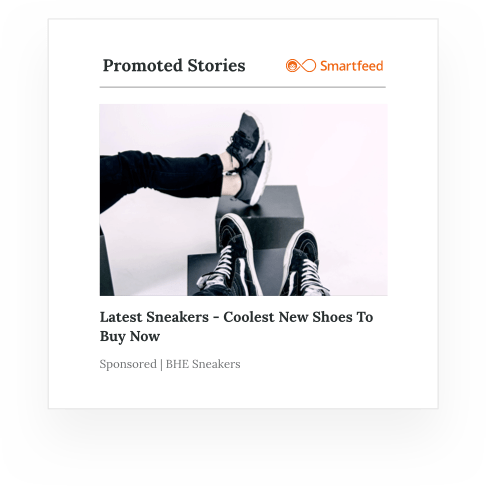
Native ads are the same on desktop and mobile; they must account for user experience on each device.
To sum up, native ads are a thorough package for ad content that can deliver the offer right to a target customer. But if you need more details, we published a guide on how to use Native Banners for growing your business.
How does native advertising work?
Native ads, like all other ad types, are based on supply and demand. Publishers on the supply side are looking to monetize their website/app by leveraging their audience and reach. On the demand side, advertisers are looking to buy ad spaces on websites/apps to increase brand awareness, lead generation, and fulfill other marketing goals.
The ad networks match the two together to create a perfect union.
The differences between native and banner ads
Banner ads are the most common type of display ads. They differ in shape and size to fit in various places on a web page, including within the content. The image below depicts banner ads in a website’s sidebar.
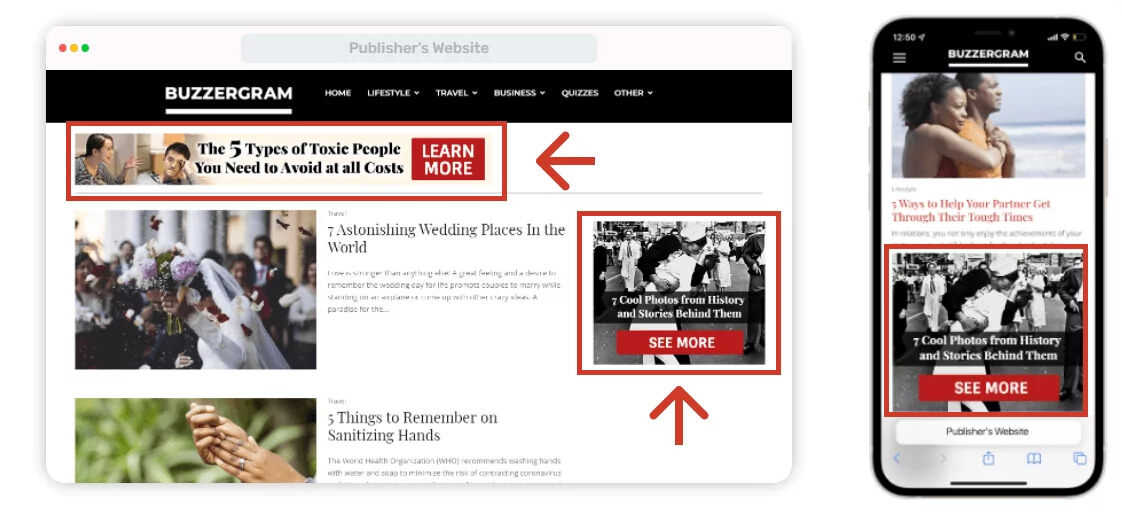
It’s obvious that banner ads are promoting something. These ads stand out from the surrounding content, making them visible.
Native ads, on the other hand, blend in with the site’s content. It’s difficult to tell that they’re ads at all.
Consumers don’t like ordinary banner ads; 46.2% of users worldwide admit to using ad blockers. Even those who don’t use ad blockers are used to ad blindness. Unsurprisingly, display ads aren’t producing the same results as before.
Native ads use a soft-sell approach. They’re integrated into what customers are already interested in. They are more likely to be read and clicked on by web users than an annoying banner ad. Furthermore, they can read, watch, or listen to native ad content.
It’s also a matter of timing. When people are consuming content online, banner ads often interrupt them. Though it’s a legit way of promotion, users often get annoyed. Native ads, on the other hand, such as recommended content widgets, appear when people are looking for more information. They do not interfere with the experience.
What are mobile native ads?
Mobile native advertising aims to match a website or app’s mobile version, including its style, form, and function. It includes sponsored content, social media ads, in-feed ads, and other types of native advertising similar to those on desktop.
Types of native mobile ads
Although native mobile advertising is a widely-used trend, business owners can still use many formats to promote their brands and remain competitive. Let’s take a closer look at the most popular types for both advertisers and publishers:
1. In-feed product listing
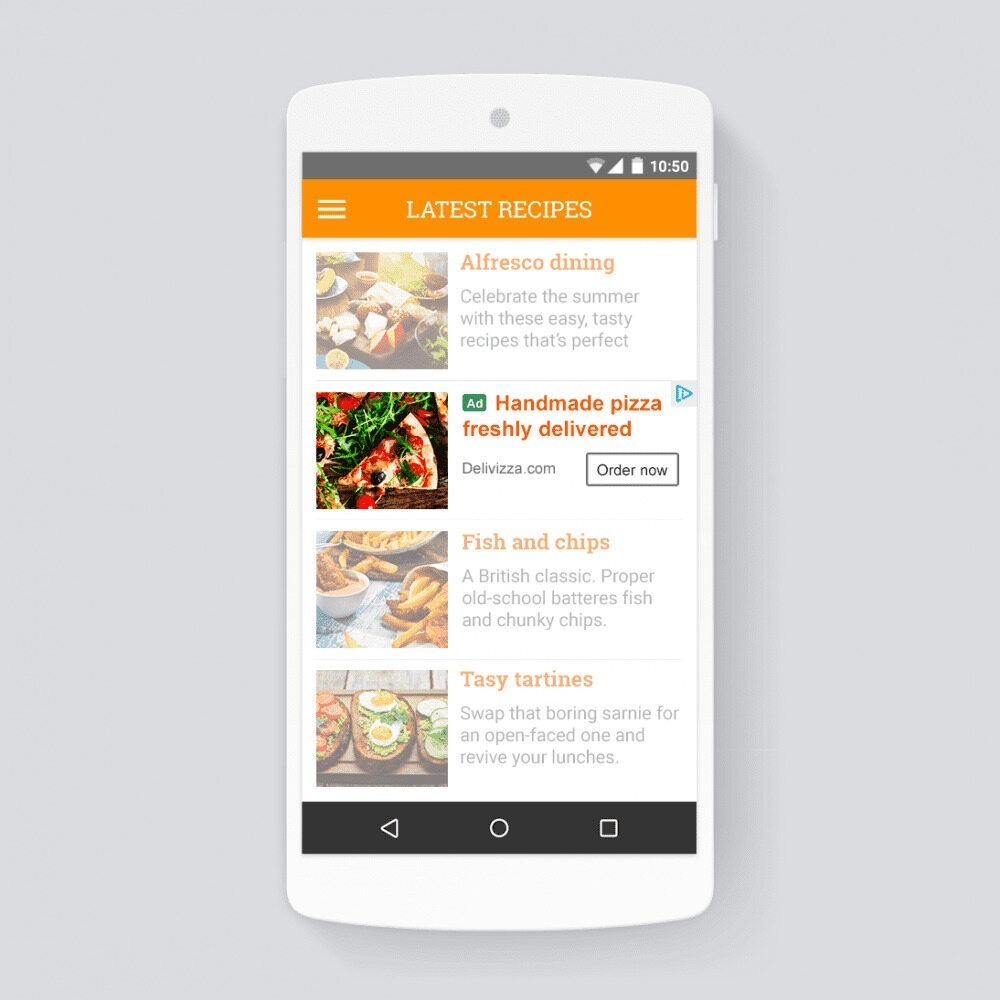
In-feed product listings often appear on commerce sites and apps. They’re designed to look like organically-listed products. A product image, a short description, a price, and user reviews all appear in this type of ad.
These advertisements work the same way organic products do on the website/app. Customers can buy, add to a cart, like, or add these sponsored products to a wishlist.
2. In-feed content

Sponsored content that appears on people’s news feeds, streaming platforms, and general blog feeds. They are designed to match the site/app design, including fonts, graphics, and other elements. Sponsored content works the same way as free content, with gestures like flipping, swiping, and viewing the feed.
How about showing your ads natively on thousands of websites to millions of users? Or, maybe, earn nice cash by exposing native advertising on your website? Nothing comes easier than a registration with Adsterra, your native advertising network.
3. In-map content

Native ads now appear in mobile map and navigation apps, including Google Maps, Apple Maps, and more. These ads appear when a user searches for a location related to the ad. Ads are made possible by mobile map apps like Google Maps. They look like organic map search results including details such as distance, working hours, customer reviews, and amenities.
4. In-game ads

These are opt-in video advertisements where players are invited to watch the ad in exchange for in-game rewards. Rewards can include in-game currency, game hints/tips, and increased player XP, among other things.
These in-app video ads are designed to complement the game’s aesthetics. When the player clicks on an icon that offers rewards for watching the ad, the ad video appears on the screen.
5. Recommended content
Recommended content helps users navigate and explore new content. These ads usually have a title that says “Recommended for you” or “You might like.” The image and text are similar to the feed or article’s design. The user experience is identical to the organic content, with a click-through button to access the full article on the advertiser’s website.
6. Custom native ads
Traditionally, custom native ads meant content created by brands: editorials, videos, and full-screen ads. That was the most expensive format due to its complex design and tailored targeting.
However, the situation changed dramatically in the late 2000s. Thousands of advertisers gained access to web push ads and then to In-Page Push ads. These are not native banners, but their nativeness beats their predecessors’.
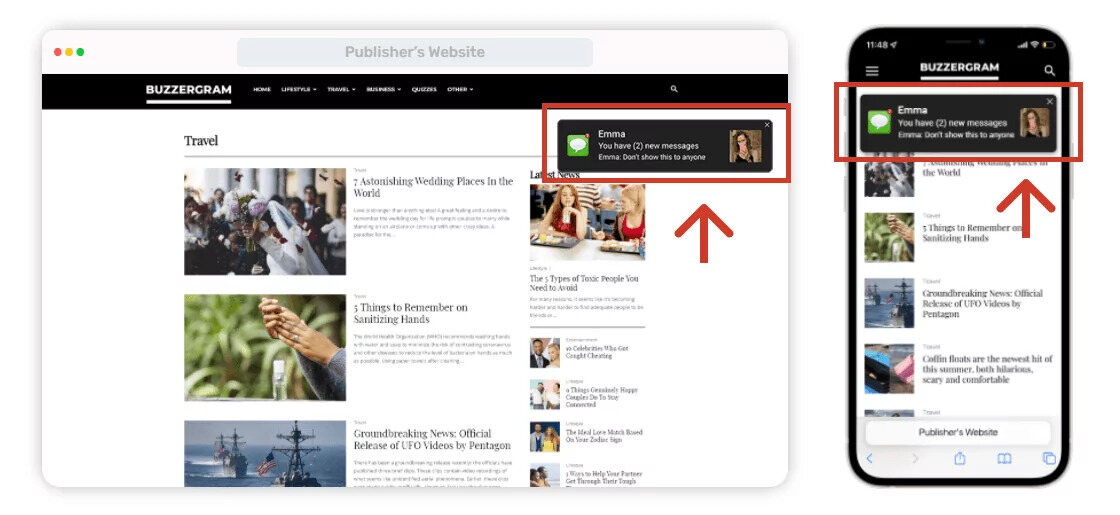
While remaining an inexpensive format, In-Page Push evolved further into the mobile-friendly Social Bar.
Social Bar ads have the teasing characteristics of native ads, but they are far more noticeable and clickable. Still, we can call them Custom because they can wrap any offers uniquely. Just look at these two ads below.
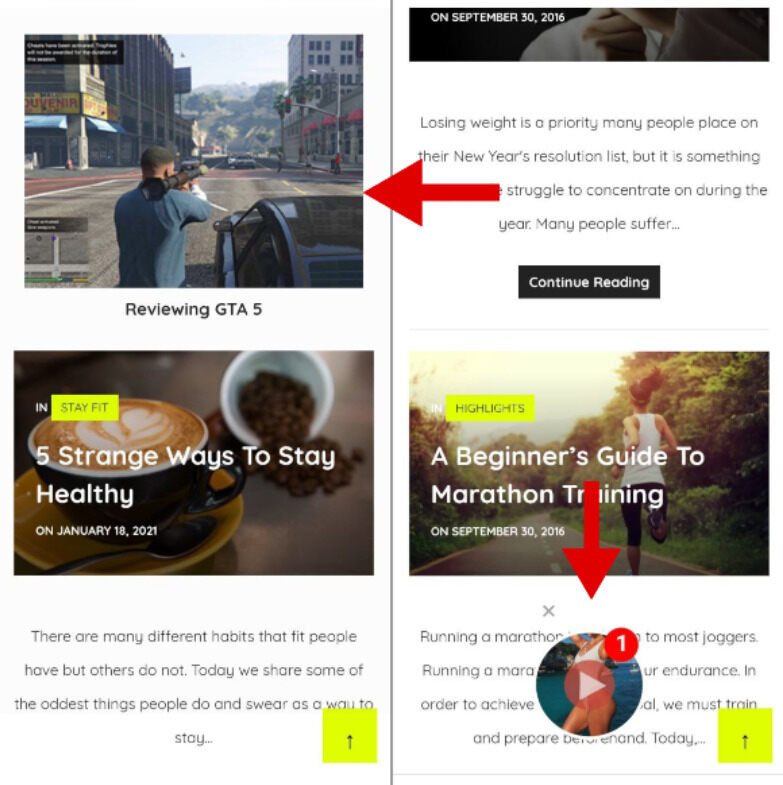
Native banner is adequate here, but the Social Bar (a pulsing icon at the bottom of the screen) truly shines.
Advantages of mobile native ads
As smartphone penetration gathers pace and native advertising on mobile reigns supreme in the content world, more business owners and publishers consider using it.
There are multiple benefits that make mobile native ads worth the trouble of integration—take a closer look at the advantages it offers to advertisers and publishers.
1. The Click-Through-Rate (CTR) is higher than banner ads
Native ads have a higher CTR than banner ads. It’s not surprising, given that such ads avoid the issue of banner blindness. Customers almost believe that the advertisement is a part of the original content. They might click on the ad without even realizing it’s an ad. Users may click native ads even if they see the “Ad” or “Sponsored” tag on the content because these ads match the style of the site/app, giving the impression that it belongs there.
2. Mobile native ads foster high purchase intent
Purchase intent refers to the customer’s intention to buy the product or service advertised in the ad. Because of their non-intrusive placement within the app and added value to the customer, mobile native ads improve purchase intent.
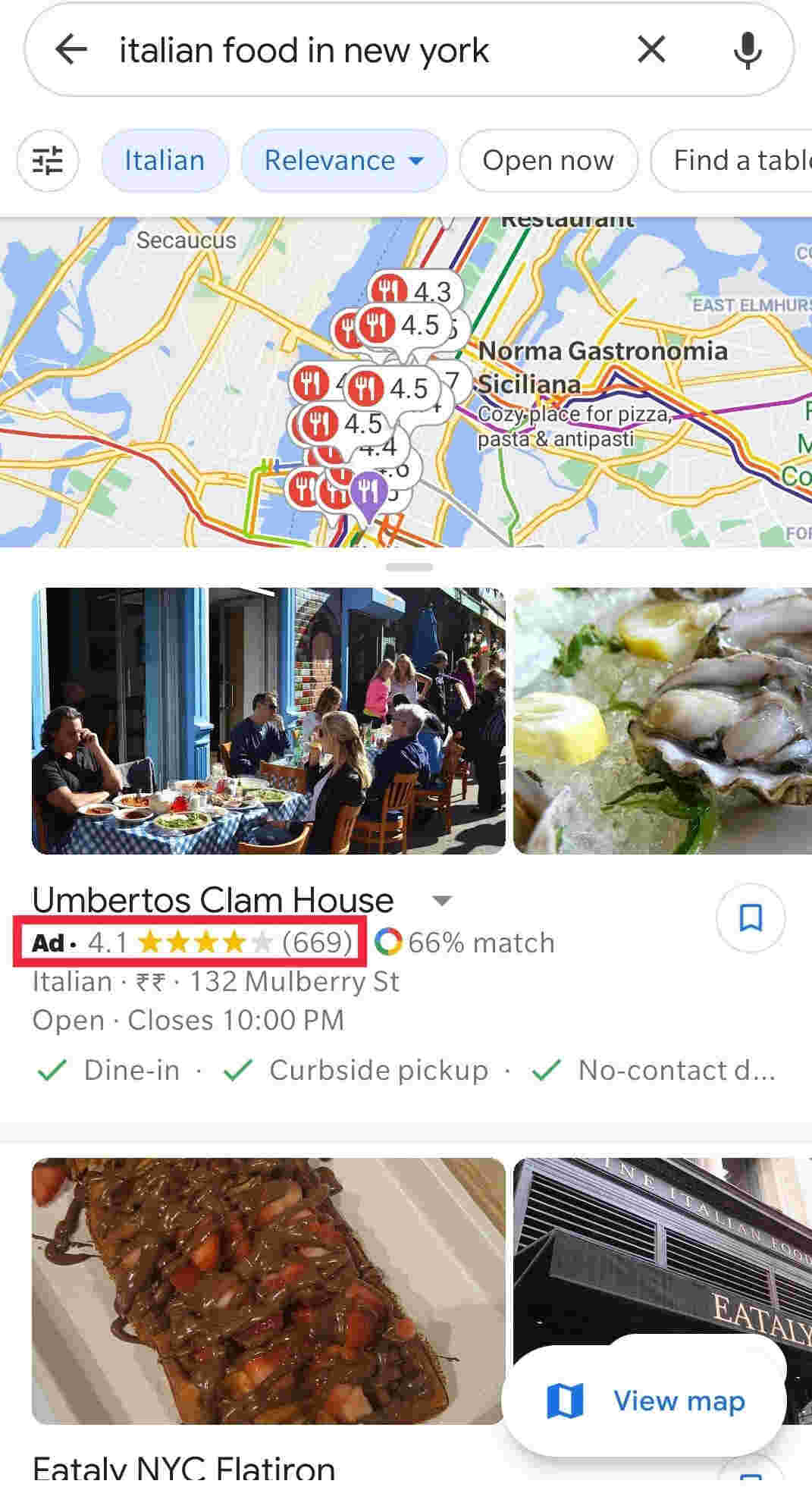
When you search for “Italian food in New York,” the ad for “Umberto’s Clam House” comes up first, as you can see in the image above. People are most likely to visit this restaurant because they are looking for a good place to eat Italian food, and Google maps displays this result at the top of the page. Even if it is an ad, no one would mind it because this recommendation has good reviews and is relevant to their needs.
3. Mobile native ads combat ad fatigue
The camouflage nature of mobile native ads engages the audience as long as the ad matches the app’s form and function, and the content is relevant and interesting.
4. Some native ad types are immune to ad blockers
Most platforms don’t have built-in ad-blockers; advertisers can use this to reach a larger audience. Ad-blockers are typically only included in paid apps that cost up to $4. Surprisingly, most of these ad-blocking apps only block ads in mobile browsers and aren’t intended to block advertising content displayed within the app. As a result, many advertisers often switch from mobile browser ads to in-app ads.
Mobile native advertising benefits for publishers
- Keep your reader base unaffected. Since such ads are non-invasive, website visitors will not be discouraged from exploring the platform (as with pop-ups and flashy banners).
- No strain on website performance. While other, flashier ads tend to slow content platforms, that’s not the case for native ads. It doesn’t matter how many sponsored posts you publish; the loading speed and user experience will not be affected.
- Editors can publish relevant posts. Native ads do a great job of blending with the organic content—sometimes, they can be creative and make for useful standalone content.
- Publishers can double their profits by combining native ads with other monetization formats, as the first ones don’t look too salesy.
Tips for mobile native advertising
Although traditional advertising is quite successful on mobile devices, the surge of advertisers eager to conquer smartphone users will lead to an increased number of people installing ad-blocking extensions.
To make sure your ads make it through the cutthroat competition, use the following tips to master the art and science of mobile native advertising.
1. Make your ad creatives similar to organic content
Most users trust the platforms they visit frequently and will click on the content that’s similar to posts they’ve chosen before. That’s why, as an advertiser, you want to keep the tone and visual style of your sponsored post consistent with what the publisher offers up to date.
To make sure your post blends in seamlessly, use these simple strategies:
- Create a list of 4-5 organic posts that resonated with you (be it because they are funny, informative, or have epic visuals).
- Create a list of posts that resonated with the audience and determine what common traits let these articles perform better than others.
- Make a list of 3-4 sponsored ads that performed well and determine what contributed to their success.
- Use spy tools to compare how teasing your creatives are against those in the market. Just as an example, the Affbank’s free spy tool can give an overview of the whole situation.
With this data in mind, it will be easier to research, outline, and design a killer native ad. Once your post is ready, run it past the editorial team and find out if it’s cohesive with the platform’s publishing practices.
2. Prepare your website for traffic
If you choose mobile native advertising, it means smartphone users will be the ones to visit your website. Hence, you don’t want them to get disappointed by the lack of responsiveness and user-friendliness.
Before starting a mobile native advertising campaign, tick these checkboxes:
- Layouts and dynamic serving;
- “Viewpoint” meta-tag;
- HTML, CSS, and JavaScript instead of Flash;
- Larger fonts (at least 14 px). The same for buttons and links;
- Great content hierarchy.
3. Create reusable ad templates
Advertisers talk a lot about creativity and originality in coming up with concepts. However, at the end of the day, most professionals value feasibility a great deal—an ability to create a high-quality ad at a higher speed, regardless of the location or the number of available employees.
To make sure you don’t have bottlenecks when creating ads, try to make them as reusable as possible. Use design templates, and a defined structure, and create a thought-out editorial plan to make sure you are never short on sponsored post ideas—this will save you a lot of time during ad design, allowing you to focus on brainstorming and looking for new promotion tools instead.
4. Stay away from clickbait
Native ads should not attempt to deceive the user. Remember that the goal is not to increase clicks at the expense of building trust. Instead of big, flashy CTAs that force the user to click, focus on delivering a clear message with elements that work well together. Never include more than one CTA; doing so will only clutter the design and confuse users. Provide a clear, compelling message that entices potential customers to learn more.
Conclusion
Mobile native advertising is the most promising format marketers can develop. It makes the most out of people’s daily habits, is non-intrusive, and appeals to one of the fastest-growing audience segments—smartphone users.
Since there are so many platforms to choose from and things to consider when launching a campaign, business owners will need the help of a professional marketing team sooner than later.
At Adsterra, we help advertisers launch revenue-driving campaigns, avoid ad fraud, and assist publishers in integrating ad placements while retaining readers. Small and medium advertisers and publishers thrive on our Social Bar format that seamlessly integrates into any content: text, buttons, or images. Larger enterprises rely on responsive display and push ad formats.
Whether you want to spread the word about your business or make the most out of your inventory, become our partner and get access to high-quality traffic and smart campaign optimization.
